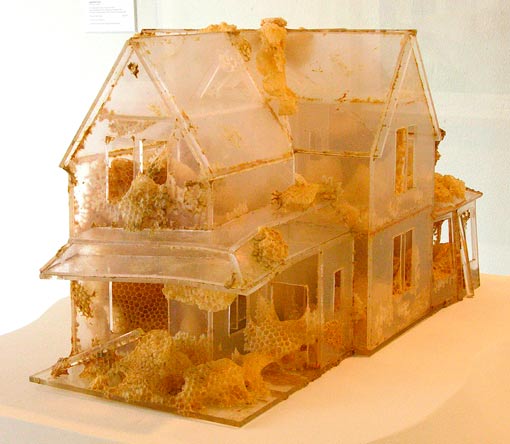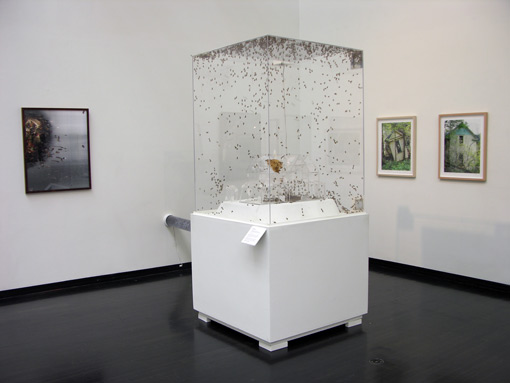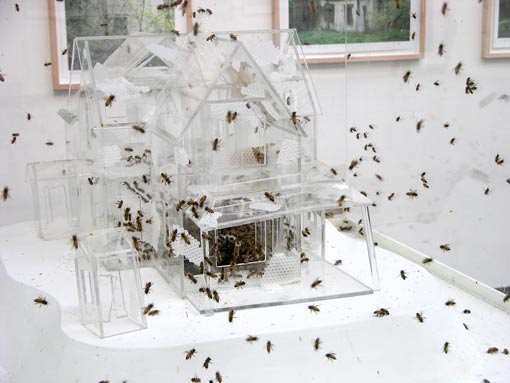Home > perm aganetha dyke
Aganetha Dyck
Aganetha Dyck, a Manitoba artist who grew up on the prairie with her Mennonite farm family, is creating a work in collaboration with a working hive of 50,000 bees. Unexpectedly, the bee industry has found new homes in the abandoned farmyards and buildings across the region. As a metaphor for change, the artist, in collaboration with Greg Vettel from the Museum staff, built a Plexiglas model of the crumbling house on the Myre place east of Reynolds, North Dakota, empty since the 1960s. Today Wayne and Michelle Larson of Buxton own and farm the property. The bees will move between the out-of-doors and their vitrine-home inside of the Museum, which will house the Myre model. Gradually the bees, in collaboration with the artist, will turn the model of the deserted farmhouse into a honeycomb work of art. The movement of the bees is fully controlled by the Museum so visitors will be able to follow their work over the course of the summer without fear of bee stings. Aganetha’s collaborator, Richard Dyck, will exhibit digital images made by placing his scanner inside the beehive to record firsthand the bees at work.
June 14 - August 1, 2005
Background of the Project :
The town of Argus was the creation of the railroad, and the railroad had no right to be there. Yet once it crossed the river there was no stopping it from going on into the emptiness. What was hauled into the Argus elevators left on the train, going east or west, and what stayed became the town. First there were the stores to supply the farmers with equipment and food, and then the banks to hold their money, and then more stores where bankers and store owners, too could shop. Houses for the town people to live in were constructed. One church was raised, another. A School. More houses for the teachers and the railroad workers and the people who built houses. Taverns for their vices. A drugstore for their pains, and so on, until Argus became the county seat. After the courthouse was built, it looked as though Argus was as up-and-coming a place as anywhere in North Dakota.
-Louise Erdrich, The Master Butcher's singing Club, 2003
Less than a hundred years later the towns are being dismantled in reverse order. The department store folds before the hardware store. The grocery store goes later. Churches close. Schools consolidate with neighboring townships and children spend hours each day on school buses. Vast systems of rural mail delivery replace the local post office. Youngsters leave for state colleges or universities, and then to an out-of-state professional or business job. Finally only the bar remains, and maybe a church. Birds are the sole tenants of uncounted abandoned buildings.
The North Dakota Museum of Art has embarked upon a multi-year project to commission artists to create new works that examine the agricultural crisis gripping the Northern Plains and its impact upon cultural and artistic life. The Great Plains is undergoing the greatest outward migration since the Depression. Every county in North Dakota is losing population except three with large cities and the four Indian Reservations. The family farm is rapidly disappearing. Small towns are fading away. Whole ways of life soon will be gone forever. Out of this change will come new ways of living on the Northern Plains, new solutions to cultural life, new methods of farming and ranching, and a new visual landscape as miles and miles of shelterbelts and tree claims, planted over the last hundred years to protect the soil from wind erosion, are removed to make way for new agricultural practices.

Aganetha Dyck, Plus the Sixth Sense, 2005-2009. Honeycomb, Plexiglas.
In collaboration with a natural beehive; Master Beekeeper, Bob Larimore of Larimore, ND; and beginning beekeeper, Dean Wallace of Lakota, ND.






